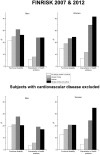Cold weather increases respiratory symptoms and functional disability especially among patients with asthma and allergic rhinitis
- PMID: 29973669
- PMCID: PMC6031646
- DOI: 10.1038/s41598-018-28466-y
Cold weather increases respiratory symptoms and functional disability especially among patients with asthma and allergic rhinitis
Abstract
Cold weather affects the respiratory epithelium and induces bronchial hyperresponsiveness. We hypothesized that individuals with allergic rhinitis or/and asthma experience cold weather-related functional disability (FD) and exacerbation of health problems (EH) more commonly than individuals without these. This was a population-based study of 7330 adults aged 25-74 years. The determinants of interest, including doctor-diagnosed asthma and allergic rhinitis, and the outcomes, including cold weather-related FD and EH, were measured using a self-administered questionnaire. The prevalences of cold-related FD and EH were 20.3% and 10.3%, respectively. In Poisson regression, the risk of FD increased in relation to both allergic rhinitis (adjusted prevalence ratio (PR) 1.19, 95% CI 1.04-1.37 among men; 1.26, 95% CI 1.08-1.46 among women), asthma (1.29, 0.93-1.80; 1.36, 0.92-2.02, respectively) and their combination (1.16, 0.90-1.50; 1.40, 1.12-1.76, respectively). Also the risk of cold weather-related EH was related to both allergic rhinitis (1.53, 1.15,-2.04 among men; 1.78, 1.43-2.21 among women), asthma (4.28, 2.88-6.36; 3.77, 2.67-5.34, respectively) and their combination (4.02, 2.89-5.59; 4.60, 3.69-5.73, respectively). We provide new evidence that subjects with allergic rhinitis or/and asthma are more susceptible to cold weather-related FD and EH than those without pre-existing respiratory diseases.
Conflict of interest statement
The authors declare no competing interests.
Figures
Similar articles
-
Asthma and allergic rhinitis increase respiratory symptoms in cold weather among young adults.Respir Med. 2014 Jan;108(1):63-70. doi: 10.1016/j.rmed.2013.10.019. Epub 2013 Oct 31. Respir Med. 2014. PMID: 24239316
-
Asthma control and cold weather-related respiratory symptoms.Respir Med. 2016 Apr;113:1-7. doi: 10.1016/j.rmed.2016.02.005. Epub 2016 Feb 23. Respir Med. 2016. PMID: 27021573
-
Allergic sensitization to laboratory animals is more associated with asthma, rhinitis, and skin symptoms than sensitization to common allergens.Clin Exp Allergy. 2017 Nov;47(11):1436-1444. doi: 10.1111/cea.12994. Epub 2017 Sep 5. Clin Exp Allergy. 2017. PMID: 28787776
-
Allergic rhinitis and asthma: epidemiology and common pathophysiology.Allergy Asthma Proc. 2014 Sep-Oct;35(5):357-61. doi: 10.2500/aap.2014.35.3794. Allergy Asthma Proc. 2014. PMID: 25295802 Review.
-
Safety of sublingual immunotherapy Timothy grass tablet in subjects with allergic rhinitis with or without conjunctivitis and history of asthma.Allergy. 2015 Mar;70(3):302-9. doi: 10.1111/all.12560. Epub 2015 Jan 14. Allergy. 2015. PMID: 25495666 Review.
Cited by
-
[Clinical and inflammatory phenotypic features of asthmatic patients sensitive to cold stimulation].Nan Fang Yi Ke Da Xue Xue Bao. 2019 Feb 28;39(2):181-185. doi: 10.12122/j.issn.1673-4254.2019.02.09. Nan Fang Yi Ke Da Xue Xue Bao. 2019. PMID: 30890506 Free PMC article. Chinese.
-
The short-term effects of different cold spell definitions on asthma outpatient visits in Lanzhou, China.BMC Pulm Med. 2025 Mar 31;25(1):145. doi: 10.1186/s12890-025-03605-0. BMC Pulm Med. 2025. PMID: 40165143 Free PMC article.
-
Association between climate indicators and hay fever incidence in children and adolescents in Freiburg, Germany.Front Public Health. 2025 Jun 4;13:1587767. doi: 10.3389/fpubh.2025.1587767. eCollection 2025. Front Public Health. 2025. PMID: 40535446 Free PMC article.
-
Activation of Transient Receptor Potential Melastatin Family Member 8 (TRPM8) Receptors Induces Proinflammatory Cytokine Expressions in Bronchial Epithelial Cells.Allergy Asthma Immunol Res. 2020 Jul;12(4):684-700. doi: 10.4168/aair.2020.12.4.684. Allergy Asthma Immunol Res. 2020. PMID: 32400133 Free PMC article.
-
Real-World Adherence and Evidence of Subcutaneous and Sublingual Immunotherapy in Grass and Tree Pollen-Induced Allergic Rhinitis and Asthma.Patient Prefer Adherence. 2020 May 13;14:817-827. doi: 10.2147/PPA.S242957. eCollection 2020. Patient Prefer Adherence. 2020. PMID: 32494127 Free PMC article.
References
Publication types
MeSH terms
LinkOut - more resources
Full Text Sources
Other Literature Sources
Medical
Research Materials


